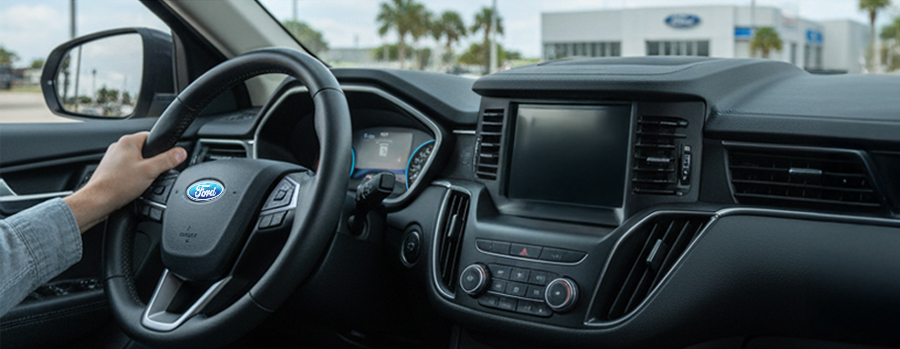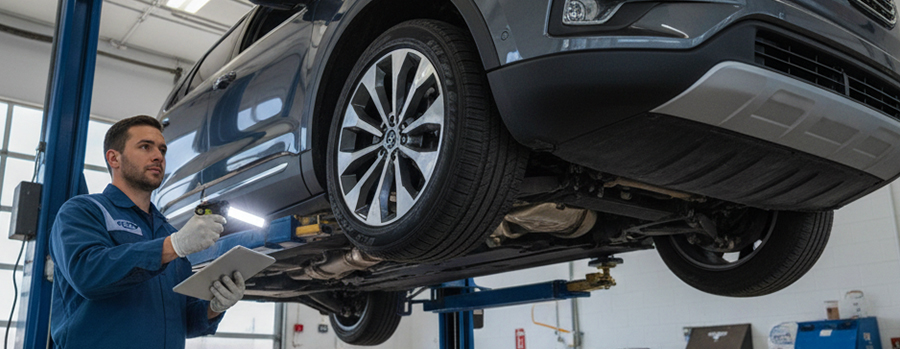11 October 2025
What to Expect from a Multi-Point Car Inspection in Plant City
You’ve probably seen the terms Multi-Point Inspection or Vehicle Check-Up pop up when booking an oil change or dropping off your car. Maybe you've even heard a service advisor mention it.
Seeing 'Multi-Point Inspection' on the list might make you think, 'Wait, isn't my oil change and tire rotation enough? Do I really need them to look at everything else?'
It’s a fair question, but that extra look makes all the difference.
While routine maintenance is crucial, a Multi-Point Inspection (MPI) is the secret sauce for keeping your vehicle in top-notch condition and preventing those nightmare breakdowns. Think of it as a thorough physical for your car.

At Jarrett Scott Ford Quick Lane® in Plant City, we believe great service shouldn't be exclusive. Whether you drive a Ford, a Toyota, or a Tesla, your car deserves the best certified care.
The Multi-Point Inspection (MPI) is a top-to-bottom physical for all makes and models. By the time you finish this, you’ll know the necessity of getting an MPI while you visit the service center.
What Is the Quick Lane® Multi-Point Inspection?
A Multi-Point Inspection (MPI) is a detailed visual and hands-on examination of your vehicle's most vital systems. It’s performed by Quick Lane certified technicians who are trained to service all makes and models.
The goal isn't just to replace worn parts, it's to use professional expertise to find potential problems before they turn into costly repairs. So, what sets an MPI apart from a regular maintenance or diagnostic check?
-
Routine Maintenance (e.g., Oil Change): This is task-focused. The technician drains the old oil, replaces the filter, and tops off fluids. It's necessary, but it's a small checklist.
-
Diagnostic Check (e.g., Check Engine Light): This is problem-focused. The technician uses specialized tools to determine the cause of a specific warning light or performance issue.
-
Multi-Point Inspection: This is preventive and holistic. The technician performs an extensive review of everything from your tires to your battery to your brake pads, looking for wear and tear, leaks, or anything that could turn into a breakdown down the road.
Why This Inspection Matters to You (and Your Wallet)
MPI is a core part of our commitment to preventive careat Quick Lane Tire & Auto Center at Jarrett Scott Ford. Quick Lane’s service is universal. Their technicians are equipped and trained to spot common wear issues across the board
1. Safety First, Always
The MPI focuses on safety-critical components: brakes, tires, steering, suspension, and lights. A small crack in a hose or a worn brake pad can be a minor repair today, but a major safety hazard tomorrow. Catching it early ensures that when you need to stop suddenly on I-4 or navigate a rainy back road, your vehicle is ready.
2. Cost Savings Through Prevention
This is the big one. Replacing an accessory belt is a cheap, fast fix. Waiting until that belt snaps, leaving you stranded and potentially damaging other engine parts, turns a minor cost into a massive, frustrating repair bill and a tow truck fee. The MPI helps you budget for necessary repairs and avoid the headache of a towed vehicle and a unexpected $1,000+ repair.
3. Maintaining Performance and Resale Value
A car that gets regular, documented inspections tends to run better, longer. Addressing small issues (like low fluid levels or a dirty filter) ensures the engine and drivetrain are working optimally. When it's time to sell or trade in your vehicle, a history of consistent MPIs shows the buyer or dealer that you've taken meticulous care of your Ford.
The MPI Checklist: What the Technician Covers
So, what exactly happens during the inspection? While every service center follows a set procedure, the technician essentially gives your car a thorough top-to-bottom review. Here’s a breakdown of the key areas they examine.

Under-Hood & Fluid Checks
This is where the heart of your car resides and it needs constant attention to run smoothly, especially in the Plant City climate.
-
Fluids: They check the levels and condition of your engine oil, coolant, brake fluid, and power steering fluid. Low or dirty fluid is a major red flag.
-
Belts and Hoses: They examine all belts (serpentine, accessory) for cracks, frays, or tension issues, and all hoses for swelling, leaks, or deterioration. A burst coolant hose on a hot day can quickly lead to engine overheating.
-
Battery: They check the battery's charge level, physical condition (corrosion), and the charging system, ensuring your car will start reliably every time.
-
Filters: Air and cabin filters are inspected. A dirty engine air filter reduces performance and fuel economy; a dirty cabin air filter reduces air quality inside the vehicle.
Under-Carriage / Drivetrain / Suspension
This part of the inspection requires lifting the car up, giving the technician a chance to spot things you'd never see.
-
Suspension: They check shocks, struts, and springs to ensure a smooth, controlled ride. Worn suspension components can affect handling and tire wear.
-
Exhaust System: They look for leaks, rust, or damage to the muffler and pipes, which can cause noise or dangerous exhaust fumes to enter the cabin.
-
Drivetrain: They inspect the transmission, axles, and driveshafts for any leaks (oil, transmission fluid) or excessive play, which indicates worn joints or seals.
Tires & Brakes
These are arguably the most safety-critical components, dictating your ability to stop and steer.
-
Tires: Technicians check the tire pressure (critical for handling and fuel economy) and measure the tread depth to ensure they have enough grip. They also look for uneven wear patterns, which can indicate an alignment issue.
-
Brakes: They inspect the brake pads for wear, the rotors for scoring or warping, and the entire hydraulic system for leaks. Knowing you have plenty of life left in your brakes provides invaluable peace of mind.
Exterior, Lights, & Safety Systems
Every light and piece of glass matters for visibility and safety.
-
Lighting: They check all exterior lights: headlights, taillights, brake lights, turn signals, and hazard lights.
-
Wipers: They test the windshield wipers and examine the blades to make sure they can effectively clear your view during a sudden Florida storm.
-
Glass and Mirrors: They check the windshield for chips or cracks that could spread.
When & How Often Should You Get a Multi-Point Inspection?
The general recommendation is simple: Get a Multi-Point Inspection every time you come in for an oil change or other routine service.
For most modern vehicles, this translates to about every 5,000 to 7,500 miles, or at least twice a year.
It's also a smart idea to get one done before a major road trip or with the change of seasons. For Plant City residents, getting a comprehensive check just before the intense summer heat hits ensures your cooling system is ready for the stress.
What You'll Get at the End: The Condition Report
You won't just get a verbal report. After the technician is finished, your service advisor will present you with a detailed Multi-Point Inspection Report Card.
This report is typically color-coded, making it easy to understand the status of every single component checked:
-
Green: Everything is in good condition and operating normally. No immediate service is needed.
-
Yellow (Caution): The component is showing signs of wear and may need attention soon. For example, brake pads are getting thin or a tire is near replacement depth. This is your cue to budget for the recommended service in the near future.
-
Red (Action Required): The component is worn out, damaged, or a safety concern that needs immediate service. This is for things like critically low brake pads, a leaking axle, or a failed battery.
This report puts you in control. It gives you a clear picture of your vehicle's health and lets you make informed decisions about maintenance, preventing the technician from ever pushing a service you don't fully understand or need.
Drive Smarter, Not Harder
A Multi-Point Inspection is your insurance policy against major breakdowns and the key to long-term reliability. By proactively spotting small issues, you ensure your Ford remains the safe, dependable vehicle you bought, helping you save money and stress down the road.
If you’re driving around Plant City, don't just ask for an oil change next time you visit the service center—ask for the full Multi-Point Inspection.
Ready to get a clear picture of your vehicle's health and drive with confidence?
Schedule your Multi-Point Inspection today at Quick Lane Tire & Auto Center at Jarrett Scott Ford Today!


